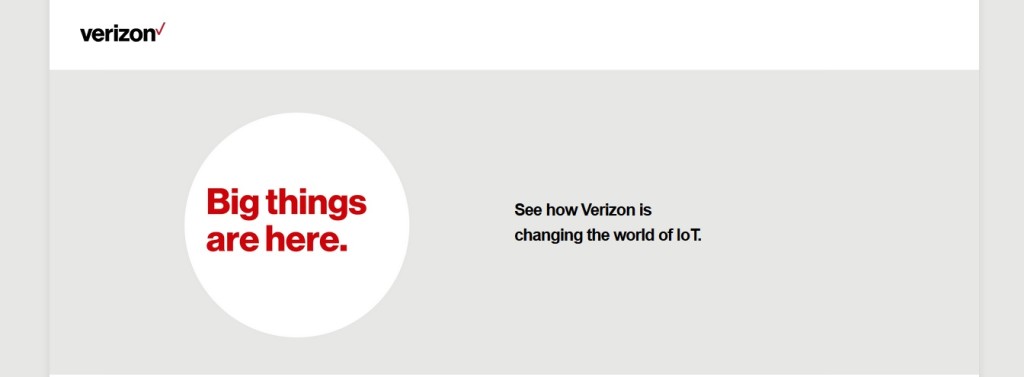San Francisco, Oct. 30, 2015: Verizon, which has added the Internet of Things (IoT) in its business offerings, has now announced its global strategy to simplify the IoT and accelerate market adoption. Verizon’s plan includes:
- Launching ThingSpace: An IoT platform that allows developers to create applications, customers to manage devices, partners to market their services, and Verizon to launch integrated vertical solutions simply, in an open environment
- Creating a dedicated network core and new connectivity options for the next-generation of IoT use cases
- Driving innovation to tackle big challenges in agriculture, healthcare, the consumer electronics evolution and the sharing economy
- Commercialising Verizon’s Big Data analytics engine for IoT deployments
- Introducing three new end-to-end smart cities solutions, Intelligent Video, Intelligent Lighting and Intelligent Traffic Management
Verizon recently claimed it was generating one of the largest amounts of revenue from the IoT compared to other companies in the United States. With an ecosystem of more than 1,000 channel partners, its revenue from its IoT and telematics solutions totaled US $495 million year-to-date.
 “Continued innovation in smart cities, connected cars and wearables demonstrates that IoT is the future for how we will live and work,” said Mike Lanman, Senior Vice President, Enterprise Products, Verizon, in a written statement. “Despite the exciting potential, IoT is still too complex, too fragmented, too expensive to connect and too hard to scale. Success in that future relies on a leader that can cut through the complexity and change the IoT model. That’s where Verizon comes in. With our experience in networks, devices, platforms and applications, we are taking a holistic approach to simplifying adoption to expand the IoT market from millions to billions of connections.”
“Continued innovation in smart cities, connected cars and wearables demonstrates that IoT is the future for how we will live and work,” said Mike Lanman, Senior Vice President, Enterprise Products, Verizon, in a written statement. “Despite the exciting potential, IoT is still too complex, too fragmented, too expensive to connect and too hard to scale. Success in that future relies on a leader that can cut through the complexity and change the IoT model. That’s where Verizon comes in. With our experience in networks, devices, platforms and applications, we are taking a holistic approach to simplifying adoption to expand the IoT market from millions to billions of connections.”
Verizon outlined its IoT strategy at an event held at its San Francisco Innovation Center. The company also showcased how it was putting its IoT capabilities to work for customers in the marketplace today through ongoing collaboration.
Projects underway include:
- Collaborating with Intel, the largest chipset maker in the world, to pilot Verizon’s agricultural platform at Hahn Family Wines, a family-owned winery based in the Santa Lucia Highlands, located in California’s Monterey County.
- Teaming up with Renesas, one of the largest suppliers of microcontrollers in the world, to enable manufacturers of connected machines in IoT and industrial segments to embed Verizon IoT’s technology early in the design process and scale quickly.
- Helping to monitor pharmaceutical products in the supply chain and improve safety utilizing Verizon Intelligent Track and Trace. Verizon’s strategic relationship with rfXcel uses IoT technology and leverages the Verizon network, to provide near real-time monitoring of product environments. The commercial launch of Verizon’s Intelligent Track and Trace Solution is expected spring 2016.
- Helping colleges and universities across the U.S. reduce their carbon footprint by up to 20 percent by powering the Innova EV Car Share fleet of all-electric vehicles with Verizon Share, an app designed for today’s sharing economy. Pilot sites include the University of Pittsburgh, Colorado State University, the University of Wisconsin–Madison and Washington State University.
Verizon’s ThingSpace allowed users to manage their IoT environments and related data, end-to-end, from device to network to application. Calling on developers, the company said the developers community could also build the IoT solutions using Verizon’s extensive capabilities and innovation resources.
As of today, all developers – even if they were not a Verizon customer – could code and test on the ThingSpace platform. The company was planning to hold a developers conference in Boston, US, in December at which a wide-range of coders including – academia, startups, business and public sector organisations – would be able to gain access to an expanded set of APIs and application enablement capabilities on ThingSpace. Verizon is expected to roll out hundreds more APIs on the platform throughout 2016.
Among the other initiatives in the IoT space by Verizon was the optimising of the network for the next-generation of IoT use cases. Verizon had created a core IoT network within its LTE architecture optimized for Cat1 devices, and also worked with partners to embed LTE chipsets in a wide-range of connected machines to automate the provisioning process and make it faster to deploy IoT devices on its wide-area network. Additional enhancements planned in 2016 included enabling Power Save Mode for IoT devices to facilitate several years of battery life.
The company was also powering IoT technology with its Big Data engine. The platform was designed to consume massive amounts of data generated by the IoT devices and other machines, analyse it at extremely high speeds and use scalable machine learning to turn raw data into usable intelligence.
Verizon had addressed the smart city market with IoT solutions for the connected car and smart grid including GridWide, Verizon Share and hum. Now Verizon was leveraging its network, cloud, security and IoT capabilities to launch Intelligent Video, Intelligent Lighting and Intelligent Traffic Management – three new solutions which will address the issues facing urban and rural communities in a more integrated and scalable way.
Image Credit: Verizon
